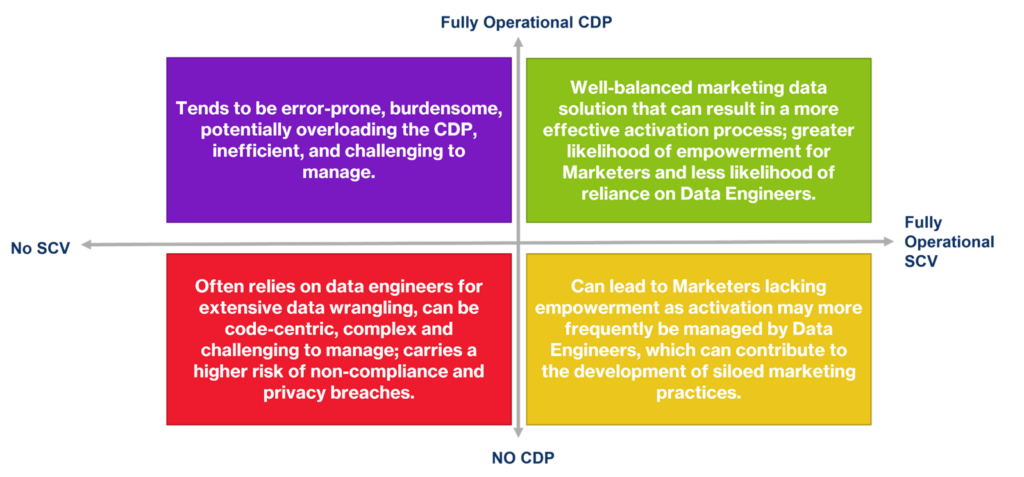CDP vs. SCV: why choosing between the two is a big mistake

In our previous post, we explained the role of the Customer Data Platform (CDP) in modern marketing architecture. Now, we turn our attention to another critical component of the marketing stack – the Single Customer View (SCV). If you’d like to read all the blogs right away, you can register here to access the complete series.
What is the difference between a CDP and a SCV?
While the CDP and SCV are often confused with each other, they serve different purposes and have distinct characteristics. In this post, we will explore the benefits of having an SCV in the foundation layer and how it differs from the CDP.
Having a Single Customer View (SCV) in the foundation layer provides several benefits for businesses. Firstly, it enables businesses to build a comprehensive understanding of their customers by providing a unified and persistent view of customer data across all touchpoints. Secondly, it allows businesses to implement governance for enterprise-wide data management, ensuring data quality and consistency. Thirdly, it supplies a reliable source of customer data for analytics, reporting and decision-making. Finally, it lays the foundation for personalised experiences by providing a complete picture of the customer that can be used by marketers to deliver targeted and relevant experiences.
The SCV is where your customer data is mastered and where your business logic and definitions are applied. The output is a clean set of validated data that is presented in a useful way for your business and is ready for use in your engagement and activation layers. The SCV is where your business can address some common and critical issues with data, such as:
- Validating and cleansing your data
- Standardising of output and definitions
- Consistent application of common business definitions and logic
- Curation and presentation of data based on business application, making the data easy to use
On the other hand, the CDP is a more marketer-centric tool that empowers marketers with the ability to activate omni-channel personalised customer experiences. It is designed to make it easier for marketers to access and use customer data without relying on data engineers or IT teams. The CDP enables companies to use customer data to deliver targeted and personalised experiences across all channels.
While both the SCV and CDP are valuable tools, they are not interchangeable but instead play complementary roles.

Failing to have both an SCV and a CDP can lead to significant risks and negative impacts. For example, without an SCV, companies may struggle to make sense of their customer data, leading to missed opportunities for personalisation and engagement. Without a CDP, companies may struggle to activate that data and deliver personalised experiences, leading to lower customer satisfaction and loyalty.
Ultimately, businesses that want to improve their customer experience should have both an SCV and a CDP. While the SCV provides a foundation layer of customer data, the CDP empowers marketers to activate that data and create personalised experiences.
How can CACI help?
As subject matter experts at CACI, we can tell you that a well-implemented CDP can be a game-changer for businesses of all sizes and we have hands on experience with many brands including ASOS, Kingfisher, L&G, PlayStation, Telegraph, EasyJet and DFS. If you’re interested in learning more about CDPs and how they can help your business, please don’t hesitate to reach out to one of our experts.
In the next post, we’ll consider how the CDP pairs with another key component of the modern marketing stack, the Customer Engagement Platform (CEP). Or if you’d like to download the full blog series in advance, click here to download.
Want to speak more about CDP and it can help you elevate your customer and marketing strategy? You can contact us here to speak to one of our experts.
Continue reading:
Blog 1 – How a CDP can transform your customer experience architecture
Blog 3 – CDP+CEP: A perfect pair for a seamless customer experience
Blog 4 – How to avoid pitfalls & drive results in CDP implementation
Blog 5 – Using CDP to design a successful business operating model